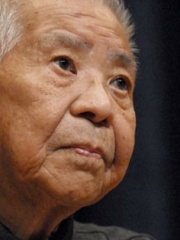
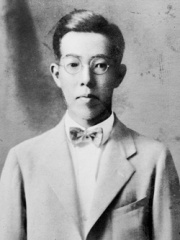

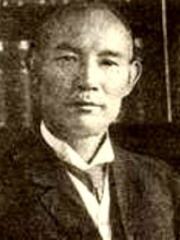
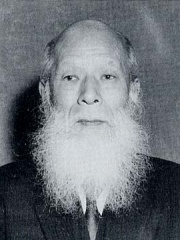
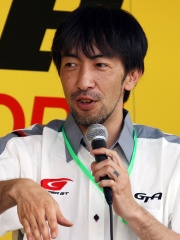
The Most Famous
ENGINEERS from Japan
Top 7
The following people are considered by Pantheon to be the most legendary Japanese Engineers of all time. This list of famous Japanese Engineers is sorted by HPI (Historical Popularity Index), a metric that aggregates information on a biography's online popularity.

1. Tsutomu Yamaguchi (1916 - 2010)
With an HPI of 71.16, Tsutomu Yamaguchi is the most famous Japanese Engineer. His biography has been translated into 43 different languages on wikipedia.
Tsutomu Yamaguchi (山口 彊, Yamaguchi Tsutomu) (16 March 1916 – 4 January 2010) was a Japanese marine engineer who survived and witnessed both the Hiroshima and Nagasaki atomic bombings during World War II. Although at least 160 people are known to have been affected by both bombings, he is the only person to have been officially recognized by the government of Japan as surviving both explosions. A resident of Nagasaki, Yamaguchi was in Hiroshima on business for his employer Mitsubishi Heavy Industries when the city was bombed at 8:15 AM, on 6 August 1945. He returned to Nagasaki the following day and, despite his wounds, returned to work on 9 August, the day of the second atomic bombing. That morning, while he was being told by his supervisor that he was "crazy" after describing how one bomb had destroyed the city, the Nagasaki bomb detonated. In 1957, he was recognized as a hibakusha ("explosion-affected person") of the Nagasaki bombing, but was not officially recognized as a survivor of Hiroshima by the Japanese government until 24 March 2009. He died of stomach cancer on 4 January 2010, at the age of 93.

2. Jiro Horikoshi (1903 - 1982)
With an HPI of 69.88, Jiro Horikoshi is the 2nd most famous Japanese Engineer. His biography has been translated into 26 different languages.
Jiro Horikoshi (堀越 二郎, Horikoshi Jirō; 22 June 1903 – 11 January 1982) was a Japanese aeronautical engineer. He was the chief engineer of several Japanese fighter aircraft designs used during World War II, most notably the Mitsubishi A6M Zero fighter, as well as the NAMC YS-11.

3. Masaru Ibuka (1908 - 1997)
With an HPI of 66.63, Masaru Ibuka is the 3rd most famous Japanese Engineer. His biography has been translated into 31 different languages.
Masaru Ibuka (井深 大 Ibuka Masaru; April 11, 1908 – December 19, 1997) was a Japanese electronics industrialist and co-founder of Sony, along with Akio Morita.

4. Hidesaburō Ueno (1872 - 1925)
With an HPI of 66.17, Hidesaburō Ueno is the 4th most famous Japanese Engineer. His biography has been translated into 16 different languages.
Hidesaburō Ueno (Japanese: 上野 英三郎, Hepburn: Ueno Hidesaburō; January 19, 1872 – May 21, 1925) was a Japanese agricultural scientist, well-known as the guardian of Hachikō, a devoted Akita dog.

5. Genichi Taguchi (1924 - 2012)
With an HPI of 59.71, Genichi Taguchi is the 5th most famous Japanese Engineer. His biography has been translated into 16 different languages.
Genichi Taguchi (田口 玄一, Taguchi Gen'ichi; January 1, 1924 – June 2, 2012) was a Japanese engineer and statistician. From the 1950s on, Taguchi developed a methodology for applying statistics to improve the quality of manufactured goods. Taguchi methods have been controversial among some conventional Western statisticians, but others have accepted many of the concepts introduced by him as valid extensions to the body of knowledge.

6. Hidetsugu Yagi (1886 - 1976)
With an HPI of 58.08, Hidetsugu Yagi is the 6th most famous Japanese Engineer. His biography has been translated into 17 different languages.
Hidetsugu Yagi (八木 秀次, Yagi Hidetsugu; January 28, 1886 – January 19, 1976) was a Japanese electrical engineer from Osaka, Japan. When working at Tohoku Imperial University, he wrote several articles that introduced a new antenna designed by his assistant Shintaro Uda to the English-speaking world. The Yagi-Uda antenna, patented in 1926, allows directional transmission using radio waves, and is especially useful in the very high frequency and ultra high frequency radio bands . Antennas of this type were widely used for television and radio reception, and are still common in communication and radar systems. Yagi also tried, unsuccessfully, to introduce a wireless power transmission system. He participated in establishing the Chiba Institute of Technology. He was the fourth president of Osaka University from February 1946 to December 1946. In 1942, he became the President of Tokyo Institute of Technology, in 1944 he became the President of the Technical Institution, and in 1946 also the President of the Osaka Imperial University. He was decorated with the Medal of Honor with Blue Ribbon Award in 1951, with the Order of Culture in 1956, and posthumously with the Grand Cordon of the Order of the Rising Sun in 1976.

7. Naoki Hattori (b. 1966)
With an HPI of 48.16, Naoki Hattori is the 7th most famous Japanese Engineer. His biography has been translated into 20 different languages.
Naoki Hattori (服部 尚貴; born 13 June 1966) is a motoring journalist and racing driver from Japan. After he won the Japanese Formula 3 championship in 1990, Hattori failed to pre-qualify for two Formula One Grands Prix with Coloni in 1991 as a late-season replacement for Pedro Chaves. He raced in Indy Lights in the mid-1990s, and in CART briefly in 1999 for Walker Racing with a best finish of 14th. In 1997, he tested a Formula One prototype, the F105, for Dome F1 at Suzuka and other Japanese race tracks, but Dome F1 never entered a Formula One Grand Prix. Hattori competed regularly at the Japanese Touring Car Championship, winning the 1996 title with a Mooncraft Honda Accord after collecting five wins and three second-place finishes in 12 starts. In 1991, driving a Nissan Skyline R32 GT-R for Nismo, Hattori, David Brabham and Anders Olofsson won the Spa 24 Hours. Hattori is not related to compatriot and fellow racer Shigeaki Hattori. He has been one of the presenters of the Best Motoring video series.
People
Pantheon has 7 people classified as Japanese engineers born between 1872 and 1966. Of these 7, 1 (14.29%) of them are still alive today. The most famous living Japanese engineers include Naoki Hattori. The most famous deceased Japanese engineers include Tsutomu Yamaguchi, Jiro Horikoshi, and Masaru Ibuka.
Living Japanese Engineers
Go to all RankingsDeceased Japanese Engineers
Go to all RankingsTsutomu Yamaguchi
1916 - 2010
HPI: 71.16
Jiro Horikoshi
1903 - 1982
HPI: 69.88
Masaru Ibuka
1908 - 1997
HPI: 66.63
Hidesaburō Ueno
1872 - 1925
HPI: 66.17
Genichi Taguchi
1924 - 2012
HPI: 59.71
Hidetsugu Yagi
1886 - 1976
HPI: 58.08
Overlapping Lives
Which Engineers were alive at the same time? This visualization shows the lifespans of the 5 most globally memorable Engineers since 1700.

